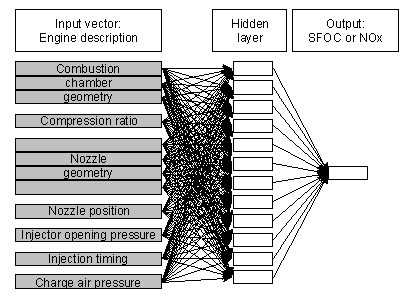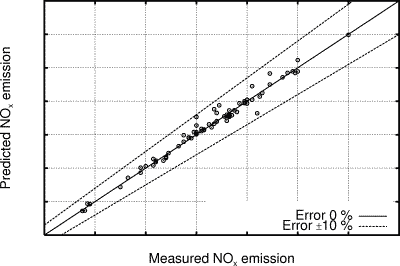
Helsinki University of Technology
|
W20perf |
Contents
Project: W20perf - Performance Development of a Medium Speed Diesel Engine
Contact: Senior Research Scientist Raimo Turunen
The power density and efficiency of diesel engines have been continuously increasing, while emission reduction efforts are always targeted on not penalising either of these. These performance characteristics can nowadays, in principle, be predicted by modern calculation methods. In this project two modelling techniques 1) CFD and 2) neural network modelling are used in analysis and development of the performance characteristics of a medium speed diesel engine. The example engine in the project is Wärtsilä 20. CFD (computational fluid dynamics) is nowadays a popular instrument in examining engine combustion whereas neural network modelling has proved successful in analysing systematically large amounts of data in many areas of science. In this project, the neural network is used to organize the huge quantity of engine test results relating to nozzle design, injection advance, combustion chamber shape, etc.
The objective of the project is to serve as a practical test for these two methods and their application in diesel combustion analysis. The optimization target was set by specific fuel consumption at 100%, smoke emission at 10% engine load engine load and NOx emission according to ISO 8178, E2 cycle.
Results analysis are verified by engine experiments whenever possible.
The project has got funding granted by TEKES, the Technology Development Agency of Finland (Engine Technology Programme ProMOTOR), Wärtsilä Technology and Fortum Oil and Gas. The project was started in 1998. The analysis tools have been evaluated; the last verifying engine tests will be done in 2001.
Generally, CFD analysis in the project was succesful although plenty of engine test data were needed for the tuning of the model. However, the simulation of internal EGR was found difficult in connection to the smoke and NOx analysis.
The use of a trained network was very fast. The drawback of this kind of neural model is that they cannot predict anything they have not learned. The neural network analysis showed that there are no better alternatives than those which had already been found in the original tests by the engine manufacturer, although it might have been possible to produce similar results with different configurations.
Fully connected feed-forward net of multi-layer perceptron (MLP) type of a diesel engine.
CFD forecasts of smoke characteristics with different injection and combustion chamber configurations
NOx emission response of the neural model compared to engine test results |


